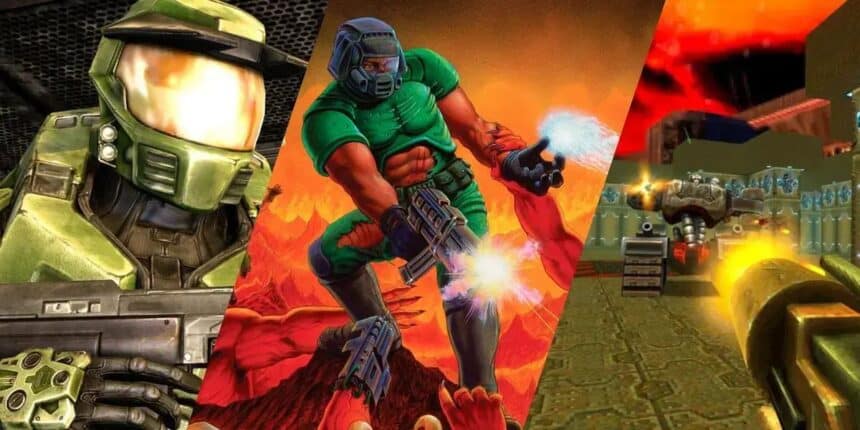Classic FPS games like Doom, GoldenEye 007, and Halo: Combat Evolved have significantly shaped the gaming industry. They introduced immersive storytelling, innovative multiplayer modes, and advanced gameplay mechanics that remain influential today. Revisiting these iconic titles not only evokes nostalgia but also highlights their lasting impact on modern game design and player engagement.
If you’re a fan of Retro FPS Games, you’re in for a treat! Dive into this nostalgic journey filled with adrenaline and pixelated mayhem. Ready to relive the excitement?
The Evolution of FPS Games
The evolution of FPS games has been exciting to watch. These games have come a long way since they first hit the market. In the beginning, FPS games were simple and low-tech. Titles like Doom and Wolfenstein 3D were groundbreaking. They laid the groundwork for what was to come.
As technology advanced, so did these games. By the late 90s, we saw a major leap with games like Quake and Half-Life. These games offered better graphics, more complex storylines, and engaging multiplayer modes. Players loved the thrill of competing with friends online.
In the 2000s, FPS games took another huge step. Titles like Call of Duty and Halo changed the landscape of gaming. Their realistic graphics and intense action captured players’ attention. Developers started focusing on creating immersive worlds that players could explore.
The introduction of console gaming brought FPS games to a whole new audience. Players enjoyed picking up their controllers and diving into action-packed adventures on their TVs. Multiplayer experiences became a key feature, making these games fun for friends and families.
Today, FPS games continue to innovate. From virtual reality to battle royale formats, they push boundaries. Players look for new experiences, and developers are eager to deliver. The evolution of FPS games shows how creativity meets technology.
What Makes a Game Retro?
Many gamers wonder, what makes a game retro? It often depends on a few key factors. Retro games are usually from the earlier days of gaming, like the 80s and 90s. They can be recognized by their simple graphics and basic gameplay mechanics. These games were made for older consoles like the NES and Sega Genesis.
One major aspect is nostalgia. Many players remember these games from their childhood. Playing a retro game can bring back fond memories, making them feel special. The soundtracks are often catchy, and the pixel art has a unique charm.
Additionally, retro games often have a distinct style. They feature 2D graphics instead of the 3D visuals we’re used to today. The gameplay is straightforward, focusing on simple controls and clear objectives. This makes them easy to pick up and play.
Technology has changed, but retro games hold a special place in many hearts. Some new games even try to capture that classic feel. They use pixel art and chiptune music to recreate the magic of retro gaming.
In summary, the combination of nostalgia, simplicity, and unique style defines what makes a game retro. For many, it’s all about enjoying the classics that started it all.
The All-Time Classic: Doom
Doom is one of the most celebrated games in history. Released in 1993, it changed how people played video games. This first-person shooter set the stage for future FPS games. It gave players a thrilling experience in a 3D environment.
The gameplay is fast and exciting. Players move through various levels filled with monsters and obstacles. With simple controls, it was easy to learn but hard to master. This blend of accessibility and challenge kept players coming back for more.
Doom’s graphics were revolutionary at the time. Though simple by today’s standards, they captured the imagination. The game’s art style created a dark and immersive world. The soundtrack added to the intensity, making every encounter thrilling.
Furthermore, Doom pioneered the concept of multiplayer gaming. It allowed players to connect through local networks. This feature made it a favorite at gaming parties. Friends gathered to compete against each other, boosting the game’s popularity.
Over the years, Doom has seen many sequels and remakes. Each version keeps the spirit of the original while adding new features. Today, it remains a beloved title among fans of retro games.
Quake 2: The Revolution Continues
Quake 2 is often seen as a major turning point in FPS games. Released in 1997, it built on the success of its predecessor. This game introduced a new level of graphics and gameplay complexity. Players were amazed by the 3D environments and realistic textures.
The weapons and combat mechanics were also improved. Players could choose from a variety of weapons, each with a unique feel and function. This variety added depth and strategy to the gameplay. It wasn’t just about shooting; it was about how to use your weapons effectively.
Multiplayer was a highlight of Quake 2. Players could easily connect online, making matches more exciting. This feature created a strong gaming community. Tournaments and competitive play became popular, bringing fans together.
Another key aspect was the game’s modding community. Players could create their own levels and modifications. This kept the game fresh and allowed for endless replayability. Modding helped launch several popular game types that are still played today.
Quake 2’s impact is still felt in modern gaming. Its innovations laid the groundwork for future FPS titles. The game’s combination of technology and design set new standards for what players could expect. Today, it remains a beloved classic among gamers.
Fantasy Meets FPS in Heretic
Heretic combines fantasy elements with classic first-person shooting. Released in 1994, it offers a unique twist on the genre. Instead of modern weapons, players use magical spells and fantasy weaponry. This blend creates a captivating experience unlike any other.
The game’s world is rich and immersive. Players explore dark dungeons, enchanted forests, and mystical castles. Each level is filled with challenges and secrets. The atmosphere draws players into its fantasy realm.
Combat in Heretic is fast and intense. Players need quick reflexes and smart strategies. The variety of spells allows for different play styles. Some players prefer powerful fireballs, while others may choose more tactical approaches.
One standout feature is the game’s soundtrack. It enhances the gaming experience with haunting melodies and epic themes. The music sets the right mood for each battle, making encounters feel even more thrilling.
Heretic also paved the way for future fantasy shooters. Its innovative gameplay and captivating design inspired many developers. Players still fondly remember this classic, appreciating its unique take on the FPS genre.
Wolfenstein: Enemy Territory’s Multiplayer Legacy
Wolfenstein: Enemy Territory is notable for its multiplayer legacy. Released in 2003, it quickly became a favorite among gamers. This game took the classic Wolfenstein formula and focused entirely on team-based action. Players must work together to complete objectives and defeat the enemy team.
The gameplay is intense and engaging. Teams of players take on different classes, each with unique skills. Whether you choose to be a soldier, engineer, or medic, every role matters. Teamwork is essential for success.
One of the best features is the variety of maps. Each location offers different challenges and requires different strategies. Players can explore bunkers, streets, and intricate buildings, making each match feel fresh and exciting.
The game’s objective-based missions keep things interesting. Players need to capture points, escort vehicles, and complete tasks to win. This creates a dynamic gameplay experience that changes with each round.
Wolfenstein: Enemy Territory is also known for its modding community. Fans created new maps, skins, and game modes. This helped keep the game alive long after its initial release. The community’s passion for the game adds to its legacy.
Its impact on team-based shooters is still felt today. Many modern games adopt similar mechanics and class systems. Wolfenstein: Enemy Territory has truly left a mark in gaming history.
Why Star Wars Jedi Knight is Essential
Star Wars Jedi Knight is a crucial title in the gaming world. Released in 1997, it offered an amazing experience for fans of the franchise. Players step into the shoes of Jedi Knight Kyle Katarn, fighting against the forces of evil. The story brings players into the heart of the Star Wars universe.
One of the game’s best features is its lightsaber combat. Players can swing lightsabers with real-time controls, feeling powerful and in control. This combat system set a new standard for future action-adventure games.
The game blends action with puzzle-solving elements. Players not only fight enemies but also explore various environments. Each level is designed to challenge players in different ways. This variety keeps the gameplay fresh and exciting.
Jedi Knight also introduced an innovative Force power system. Players can use abilities like Force Push and Force Pull. These powers add a creative element to gameplay and create unique strategies for combat.
The multiplayer mode is another highlight. It became a favorite among players. Friends could compete in lightsaber duels or team up to battle enemies. This community aspect helped the game thrive and created lasting friendships.
Overall, Star Wars Jedi Knight remains essential for fans. Its engaging story, impressive gameplay, and strong community impact make it a timeless classic. It paved the way for many future titles in the franchise.
The Impact of GoldenEye 007
GoldenEye 007 changed the landscape of first-person shooters when it was released in 1997. This game brought James Bond to life in a new way. Players could experience thrilling missions and action-packed gameplay on the Nintendo 64.
One major impact of GoldenEye was its multiplayer mode. It allowed friends to compete against each other in exciting matches. This social gameplay became a staple in FPS games. It paved the way for future multiplayer experiences.
The game’s level design was innovative and engaging. Players could explore intricate environments, solving puzzles and facing enemies. Each level was crafted to offer unique challenges and objectives. This provided a sense of progression and achievement.
GoldenEye also introduced various weapons and gadgets. Players could choose from a wide range of tools to complete missions. This added depth to the gameplay, allowing for different strategies and play styles.
Not to mention, the game’s graphics and controls set a new standard for console FPS games. The combination of smooth controls and impressive graphics enhanced the players’ immersion. It made them feel like they were part of an action movie.
The influence of GoldenEye 007 is still felt today. Many modern shooters borrow elements from its design and multiplayer features. Overall, GoldenEye 007 remains a classic that revolutionized gaming and defined a generation.
Underrated: Turok 2 and Its Charm
Turok 2 is often overlooked, but it has a special charm that deserves attention. Released in 1998, it continued the story of Turok, a time-traveling warrior. Players battled dinosaurs and other creatures in a thrilling, action-packed world.
The game features an engaging story and vast environments. Players explore different levels filled with secrets and challenges. The variety of locations adds excitement to the gameplay. Each level feels unique and vibrant.
One of the standout features is the weapon variety. Players can use everything from simple arrows to powerful guns. This gave players many options to tackle enemies. The combat feels satisfying and combines strategy with action.
Turok 2 also introduced a multiplayer mode that offered hours of fun. Friends could compete in duels or play cooperatively through levels. This added a social element that many enjoyed.
The graphics were impressive for its time. The lush environments and detailed character designs drew players in. The game’s visual style helps create an immersive experience.
Despite its age, Turok 2 remains a classic for fans of action games. Its combination of adventure, combat, and exploration makes it an underrated gem in gaming history.
Half-Life: The Game That Changed Everything
Half-Life is often called the game that changed everything for first-person shooters. Released in 1998, it broke new ground in storytelling and gameplay. Players stepped into the shoes of Gordon Freeman, a scientist fighting for survival. The immersive story and engaging gameplay hooked players from the start.
One major innovation was the use of scripted sequences. Instead of just shooting enemies, players experienced events that moved the story forward. This made the game feel cinematic and engaging. Players could see the world change around them as they progressed.
The AI of the enemies also stood out. They were smarter and more challenging than in previous games. Enemies worked together, making battles feel dynamic. Players had to think strategically to survive each encounter.
Half-Life’s environment was richly detailed. It featured varied settings, from labs to alien worlds. The graphics, while simple by today’s standards, were cutting-edge at the time. Players felt immersed in this rich and varied universe.
The game’s success led to numerous expansions and sequels. It also inspired many other developers. Elements from Half-Life can still be seen in modern shooters today. Its impact remains significant in the gaming industry.
Medal of Honor’s Cinematic Experience
Medal of Honor is known for its cinematic experience in video games. Released in 1999, it set a new standard for storytelling and immersion. Players engage in intense action during World War II missions that feel like a movie.
The game’s graphics and sound design are impressive for its time. Players can hear authentic gunfire and experience realistic battlefield sounds. These elements make each mission feel alive and immersive.
One standout feature is the strong narrative. Players follow a compelling story while fighting through historic battles. This storytelling draws players in and gives context to their actions.
Mission design is varied, keeping gameplay fresh. Players must complete different objectives, from stealth operations to all-out assaults. Each mission feels unique and exciting, which keeps players on the edge of their seats.
Additionally, the AI in Medal of Honor is noteworthy. Enemies respond realistically, making combat intense and challenging. Players have to think strategically to survive, adding depth to the gameplay.
Medal of Honor truly shaped the first-person shooter genre. Its cinematic approach influenced many following games, proving that storytelling and gameplay can go hand in hand.
Halo: Combat Evolved, the FPS King
Halo: Combat Evolved is often regarded as the king of first-person shooters. Released in 2001, it was a launch title for the Xbox and changed the gaming landscape forever. Players took on the role of Master Chief, a super-soldier fighting against alien forces known as the Covenant.
The game introduced a compelling story filled with rich lore. Players explore mysterious worlds and uncover ancient secrets. This deep narrative kept players invested in the game throughout their journey.
One major innovation was the game’s control scheme. Halo offered smooth, intuitive controls that made shooting and maneuvering feel natural. Players could easily aim and shoot, which improved the overall gameplay experience.
The vehicle combat was another highlight. Players could drive different vehicles, like the Warthog and Ghost. This added variety to gameplay, allowing players to approach battles in new ways.
Halo’s multiplayer mode became legendary. Players could connect via local area network (LAN) or online, creating exciting matches with friends. Custom games and team battles brought players together, making it a favorite for many.
Even today, Halo: Combat Evolved remains influential. Many modern shooters take inspiration from its mechanics and gameplay elements. It set a high standard for future FPS games to follow.
Conclusion: Revisiting the Classics
As we look back at the classics, it’s clear they shaped gaming history. Games like Doom, GoldenEye 007, and Halo: Combat Evolved set new standards for what games could be. They introduced elements like immersive storytelling, engaging gameplay, and innovative multiplayer modes.
Revisiting these classics reminds us of the fun and creativity of early gaming. They capture the spirit of adventure and challenge that many players loved. The nostalgia evokes cherished memories and inspires new gamers to discover these titles.
Modern games often pay tribute to these classics, showing their lasting influence. Developers continue to draw from the lessons learned in game design and storytelling. This connection keeps the legacy of these beloved games alive.
Whether you’re a veteran gamer or new to the scene, exploring these classics can be a rewarding journey. They provide insight into the evolution of gaming and offer experiences that still resonate today.







